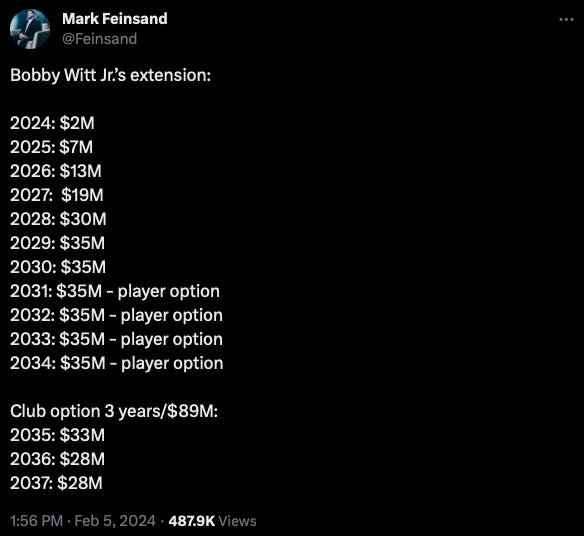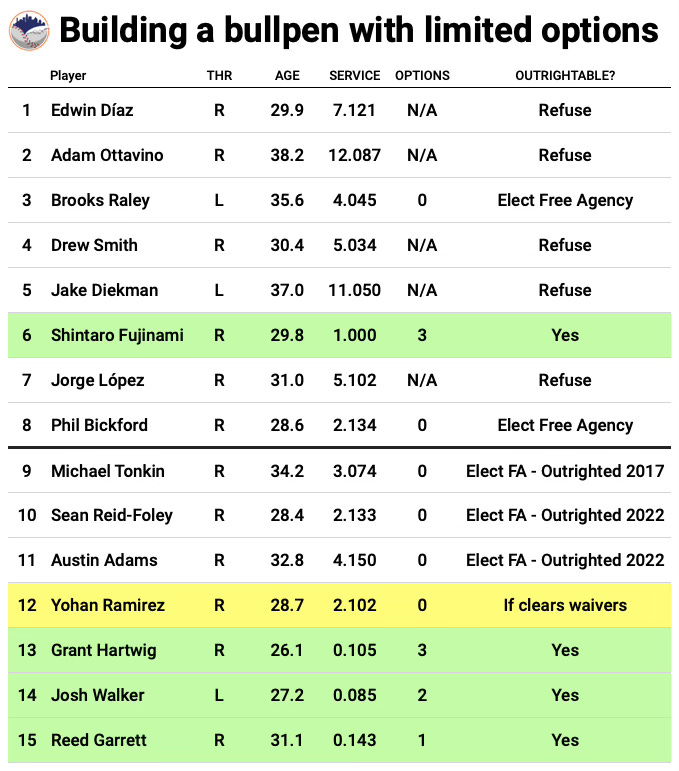☕️ Good Morning:
We have a busy newsletter on a slow news day as we talk about the significance of Bobby Witt Jr.’s contract extension and examine the flexibility (or lack thereof) in the Mets’ bullpen.
☀️ We are 6 days away from pitchers and catchers reporting. Grab your coffee for your morning dose of Mets Fix!
Happening now: The Royals continued an emerging industry trend by signing 23-year-old shortstop Bobby Witt Jr. to a staggering 11-year, $288.8 million contract extension.
Why this matters: Teams have finally figured out it makes more sense to extend players early in their careers. Rather than lavishing big bucks on a player later and worrying whether they will remain productive into their late thirties, why not just pay them for the years you know they will be productive?
This tactic is quite familiar to Mets fans who have been paying attention to the Braves over the past few years. The concept has grown wings throughout baseball with small-market teams locking up young talent to long-term deals that essentially “buy-out” extra years of team control.
While the Mets could have a candidate for an early extension in Franciso Álvarez, the train has departed on a similar type deal for Pete Alonso. The 29-year-old remains without a contract extension entering his walk year, leaving the Mets in a position where they will likely need to pay him at a premium rate as he approaches 40 to keep him in New York.
How it works: A well-structured extension allows everyone to win. In Witt’s case, he guarantees himself over $280 million as long as he wants to stay in Kansas City until 2034. He also gives himself the opportunity to earn an extra $89 million later in his career. Meanwhile, the Royals gain four years of team control — instead of Witt being eligible to become a free agent after the 2027 season, his first player option doesn’t kick in until after the 2031 season.
By backloading the deal, the Royals pay Witt close to what he would have otherwise received in arbitration through 2027, boosting the dollar value later in the deal to be more competitive against what he might receive as a free agent, while stretching the AAV of the contract for luxury-tax purposes.
🤔 What’s the opposite of optionality?
After Billy Eppler infamously built the 2023 Mets bullpen with a preference towards “optionality,” David Stearns is taking the opposite approach this offseason. In fact, there’s a chance Shintaro Fujinami might be the only optionable arm to start the season in the bullpen.
Limited flexibility: Injuries could ultimately change the roster dynamics, but the Mets are currently in a position where they could have to expose at least four pitchers to Outright Waivers in finalizing their 26-man active roster. That number only increases if they want to include any of Grant Hartwig, Josh Walker or Reed Garrett to start the season.
The rules: Players with at least five years of service time can refuse assignment to the minor leagues. Everyone else must have minor-league options remaining; and if not, they can still be sent to the minors after clearing Outright Waivers as long as they don’t fall into a special case that allows them to elect free agency.
Elect free agency: Since 40-man roster spots aren’t easy to come by early in the season, the Mets can probably sneak some of these players through waivers. However, there still could be a cost associated with doing so, especially as the season wears on and if any of them prove serviceable.
Players with “Super Two” status (Phil Bickford), with three years of service time (but less than five), or who have been outrighted previously in their careers can elect free agency instead of accepting an assignment to the minors.
They can do so immediately, or defer it to the end of the season unless they are eventually returned to a Major League roster prior to making such election.
Consequences: This means the Amazins could lose any of Phil Bickford, Michael Tonkin, Sean Reid-Foley, Austin Adams, and Yohan Ramírez either in-season or after the season as free agents instead of maintaining club control.
More to consider:
Phil Bickford is the only arbitration-eligible player who hasn’t yet settled with the team. He has incentive to sign prior to an arbitration hearing to make his 2024 contract guaranteed. If he goes to a hearing, the Mets could release him and owe only 30 or 45 days of termination pay, depending on when he is released during Spring Training, and assuming the team can prove he was outperformed by another player.
If Bickford makes the roster, and is eventually outrighted, he must accept the assignment or elect free agency immediately (he can’t defer it until the end of the season) as a Super Two player.
Upcoming trade? Doing the math, it makes you wonder if a trade is coming. We saw the Dodgers trade left-hander Caleb Ferguson — who has been a key bullpen piece for them but can refuse assignment to the minors — to the Yankees for an optionable lefty and a young prospect. Similar to the Mets, they needed to create some flexibility after signing a preferred veteran option (Ryan Brasier).
Thinking along similar lines, perhaps Drew Smith becomes a trade chip as a reliever with plus stuff who is set to become a free agent next winter. His market wouldn’t be Caleb Ferguson’s but perhaps the Mets could find a younger piece while creating more opportunity for the relievers listed above.
They will certainly monitor the interest on any of the players they will have to eventually expose to waivers to evaluate if they can sneak them by or perhaps net a small return.
🎧 Mets Fix Podcast
Make sure you are subscribed to the Mets Fix Podcast on your favorite platform.
🔹 While the Mets are likely committed to Mark Vientos and a carousel of options at DH, it’s not impossible the Mets could add a DH if the market falls perfectly in their favor. As Andy Martino explained on Baseball Night in New York: “If David Stearns went to Steve Cohen and said we can drastically improve our offense for X Amount of money, a couple million. Of course they would do it.”
🔹 Brandon Nimmo discussed playing left field and Pete Alonso’s contract situation while appearing on The Show podcast with Joel Sherman and Jon Heyman.
On playing left field: Stearns called Nimmo early in his tenure to give him the heads up that he might sign a defensive center fielder to which Nimmo responded, “Honestly, David, if it makes our team better then I'm all for it. I just want to be competitive, I want to make the playoffs and I want to have a chance to win the World Series.”
On Alonso: “I really think he wants to and he should stay a New York Met. Ultimately, that will come down to what happens this season and this offseason, and what is best for him and his family.”
◾️ As noted, the Dodgers traded left-hander Caleb Ferguson to the Yankees for lefty Matt Gage and prospect Christian Zazueta. They also re-signed reliever Ryan Brasier to a two-year, $9 million contract.
◾️ A Nevada teachers union is suing to block the Athletics’ Las Vegas stadium deal.
◾️ The Giants are reportedly in talks with slugger Jorge Soler.
🔗 Mets Top 30 prospects for 2024 season, by Joe DeMayo, SNY: “The organization has been slowly building up this system by avoiding free agents attached to draft pick compensation, and being selective regarding which prospects they're willing to trade for big league pieces. It is an important year of evaluation for president of baseball operations David Stearns, with the big league payroll clearing significantly after this season -- just in time for a very strong free agent class. And I’d expect to see a different-looking offseason than the one the Mets had in 2023-24.”
Thanks for reading! Follow us on Twitter for regular updates until our next newsletter.
And please check out our newsletters about the Knicks and Isles, too.










Again, I start with trying to understand what the Mets & Stearns are doing. And to my mind, he is executing a plan. Grabbing a high number of interesting arms on the cheap in the hope that 2-3 rise up and succeed. It's not crazy. They've decided against overpaying for uncertainty, so have gone a different direction. When they had $12 million to spend, they grabbed 3 guys rather than one "good" guy. It's a strategy that may or may not work. No one knows.
I think it's also a belief that teams need to develop their own young relievers. To get the really good guys, maybe the best strategy is to develop them instead of wildly overpaying for relievers who are famously up and down.
In terms of optionality, I see the hand-wringing but think it's largely unnecessary. The "optional" guys the Mets prized in 2023 were of inferior quality. Pretty much none of them had ever experienced success or projected as possibly having high-grade stuff. This year, Stearns has gone after guys who are a cut above that. Most of them have shown flashes, experienced some degree of success.
And now we have Spring Training. The staff will work with these guys for 7 weeks. Some will get hurt, some will impress. We'll get a lot of data, see who is coachable and who is banged up. Best case, the pen is too crowded at the end of Spring Training.
There will be options: 1) Trade the guy; 2) Release the guy.
Now often when clubs release a guy -- say Reid-Foley, for example -- the Mets will say, "Hey, we love your arm and your attitude, it's a numbers thing. Go out and by all means sign a ML deal if you can get one. But if not, you are welcome here -- you know our staff, you know the facilities, and you know how it works. You will get a shot. All you have to do is pitch well. Good luck."
A high percentage of these guys get released and resign with the organization. Some go find better deals. But if that's the case, you can usually trade that guy for something/anything.
I don't think it's a problem.
I think they are doing something different from last season and people don't understand what's happening yet.
Of course, it might not work. But I respect the thinking behind it and admire the way he's executed the strategy. There are no guarantees.
Fans just want to whine and complain and spent like crazy. Well, that's not happening. The Mets are trying to think beyond 2024.
And also -- I've said this before -- Stearns has no idea who he's got. He wants to see these players, Baty & Viento & Butto, etc -- and he wants *his guys* that he trusts to evaluate them, too.
It will be an interesting team in a transitional year. 82 wins might be 86 or it might be 76. Oh well. They are following a plan. This is Year One. I'm going to enjoy it.
What happened to optionality? a.k.a. Stearns was not impressed with Billy Eppler's ideas about constructing a roster.
Brandon Nimmo is a very good Met. Many players are so concerned about talking about "myself" so Brandon's team first attitude is refreshing.